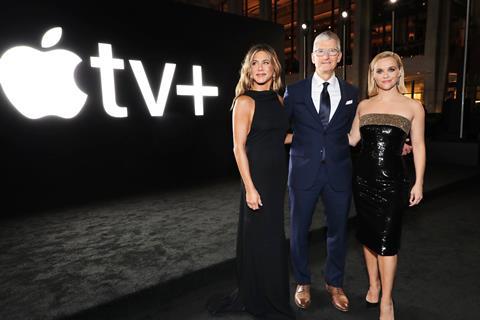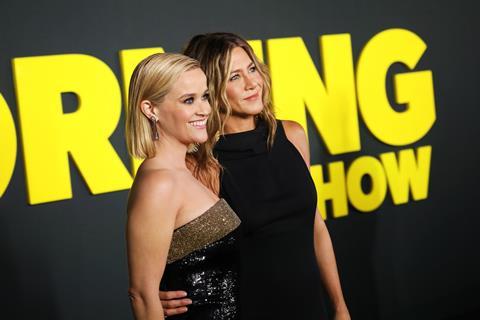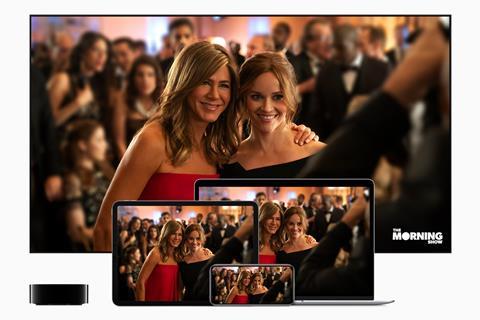In the first of series of reports on the new players launching into the streaming market, Tim Dams looks at the Apple TV+ offer – and weighs up its chances of success.

And so the second phase of the streaming revolution begins.
This Friday (1 November), Apple joins the streaming fray, the first in a line of companies treading the OTT path pioneered by Netflix, Amazon and Hulu. Disney follows later this month, with HBO Max, Peacock and Quibi set to come next year.
Among the newcomers, Apple has two distinct advantages.
- Read more: Overcrowding in the OTT landscape
Arguably the most significant is its user base. Consumers who buy any new Apple hardware –the iPod Touch, the iPhone, iPad, Apple TV streaming box or Mac computer – will get one year of Apple TV+ service free. Historically, Apple sells more than 250 million of these devices a year, so it immediately goes into direct competition with Netflix with 158 million subscribers, Amazon Prime Video (over 100 million subscribers) and Hulu (28 million subscribers).
Secondly, Apple TV+’s $4.99/£4.99 a month price is key, coming in significantly below Disney+ at $6.99 a month and Netflix, which is priced between $9 and $16 in the US, and the $14.99 to be charged by HBO Max.
“$4.99 is probably cheap enough for inquisitive Apple customers to take a plunge on” Tom Harrington, Ampere Analysis
“As it stands $4.99 is probably cheap enough for inquisitive Apple customers to take a plunge on,” says Tom Harrington, senior research analyst at Enders Analysis. He says the price is “cheap enough to worry Netflix” – not necessarily because it will lose subscribers to Apple – but because for Netflix “reaching sustainability requires raising prices.”
Whether Apple can keep customers is, however, the big question.
Core content
Apple is launching with only nine shows – a drop in the ocean compared to the number of titles available on rival services.
Among them are big budget, starry offerings: The Morning Show, starring Jennifer Aniston, Reese Witherspoon and Steve Carell, follows a popular news programme grappling with the aftermath of a sexual misconduct scandal; See stars Jason Momoa in a world where the human race has lost its sense of sight; Dickinson follows Hailee Steinfeld as a young Emily Dickinson in a coming-of-age comedy; and For All Mankind imagines an alternate history in which the space race never ended.
- Read more: Apple to put services at its core
However, three of them received tepid reviews this week from trade paper Variety, which concluded that The Morning Show “gives up on its potential before it’s really underway”, See aims for the look and tone of Game of Thrones but is “lower of brow, and sadly, of quality”, while Dickinson is a “strange experience.” For All Mankind is described as by far the strongest, making “the most of its budget and subsequent capacity to dream a bit bigger than most.”

Also on the launch slate are kids programmes Helpsters, Snoopy in Space and Ghostwriter, nature doc The Elephant Queen, and book club content from Oprah Winfrey.
In total, Apple has announced a small catalogue of 40 original TV shows, focused around star talent.
“Its consumer-facing pricing will be expensive for such a small catalogue,” notes Ampere Analysis research director Ed Border.
Enders’ Harrington adds that, for Apple, “it will take years to build the cohesive library that many consumers will expect from a paid service.”
iSpend
Apple is also spending less than rivals. Apple has reportedly set aside $6 billion for original shows and movies. The budget for the first year of content was $1 billion, but has since expanded, reported The Financial Times. That’s far less than the $14 billion that Netflix is expected to spend this year on films and TV shows.
Coming up later in the year on Apple TV+ is more star driven fare: Servant from director M. Night Shyamalan (28 November), Truth Be Told, with Oscar winner Octavia Spencer (6 December ), and several other series and movies that haven’t been given airdates yet. They include film The Banker, starring Anthony Mackie and Samuel L. Jackson as two African American entrepreneurs in the 1950s.
Apple will also be bringing back Steven Spielberg’s 1980s anthology series Amazing Stories and recently outbid HBO to get the third of Spielberg and Tom Hanks’ World War II projects, Masters of the Air.
The new series will drip onto the service slowly, in contrast to Netflix which tends to release whole seasons at once for bingeing.
Apple is releasing the first three episodes of most of its series initially, and then adding subsequent episodes weekly, thus “drawing out the value of their programming and raising the likelihood of simultaneous viewing – only then can any of the shows garner organic buzz, which is required to make the TV app a destination for content and kickstart the company’s aim to upsell these viewers with further video subscriptions,” says Enders Analysis’ Harrington.
Broad audience
On the plus side, Apple’s content could appeal to a broad audience. Ampere has drilled down into Apple’s content offer, noting that it is “much more progressive” than Disney+ in terms of the gender of programme leaders, describing it as weighted further towards the female than the male-led titles.
Ampere research also shows that Apple TV+ is heavily scripted-focused with 86% of commissions scripted, majoring on sci-fi, crime and drama. The majority of its content – 94% - comes from the US, showing how it has yet to localise. By contrast, half of Netflix’s upcoming originals come from outside the USA
Original content, however, is only part of the offer. Apple is also upgrading its Apple TV app to allow users to subscribe to more content from other broadcasters.
Apple has partnered with networks including HBO, CBS All Access, Showtime and Starz, aiming to act as a gateway to their content via a new service known as Apple TV Channels, a similar service to that already offered by Amazon as part of its Amazon Channels programme. Netflix, however, has already confirmed that it will not participate in this ‘bundle’ offer.
Partnered services will be fully integrated into Apple’s offering, with subscribers kept in-app. In return for a revenue share, which in Amazon’s case ranges from 15- 50%, Apple will assume responsibility for the hosting, marketing and customer data of these in-app services.
In terms of distribution, the service will initially be more widely available on devices rather than on the living room television – a factor which could limit subscriptions in the early days.

The Apple TV app comes pre-installed on iPhone, iPad, Apple TV and iPod touch and on the Mac with macOS Catalina. The app is also available on select Samsung smart TVs, but it will come to Amazon Fire TV, LG, Roku, Sony and VIZIO smart TVs “in the future”, according to Apple.
The iPhone-maker said that its originals will be available subtitled and/or dubbed in nearly 40 languages. Apple TV+ series and movies will also be available with audio descriptions in eight languages.
As for the verdict on the prospects for Apple TV+, analysts and the city certainly seem to like it. Morgan Stanley analysts estimate Apple TV+ could be a $9 billion-per-year business by 2025, even with conservative sign-up estimates – and raised its price target this week on Apple stock by 17% as a result.
“Apple TV+ can become a $9billion revenue business by 2025” Katy Huberty, Morgan Stanley
“With an attractive price point at $4.99/month, and wide initial distribution to the Apple installed base via the bundled free year offer, we estimate Apple TV+ can become a $9billion revenue business with 136 million paid subscribers by [full year 2025], assuming just 1 in every 10 Apple user pays for the Service by [full year 2025,” Morgan Stanley analyst Katy Huberty predicted in a note last week.
Enders Analysis says Apple TV+ is hardly a “Netflix killer”, given its “less-expansive” line up of content. “This said, the combination of the new service and the à la carte channels offering has the potential to accumulate engagement and create a TV ecosystem that would diminish the value that subscribers feel they get from their Netflix (or cable, or Amazon…) subscription.”
At the very least, a formidable and well-funded new player has just joined the streaming war – and one that should not be underestimated.
2020: The year of the OTT
- 1
- 2
- 3
- 4
- 5
- 6
 Currently reading
Currently readingApple bites into the streaming market





























No comments yet